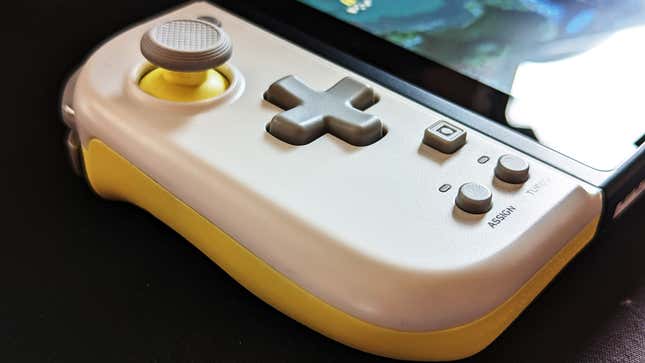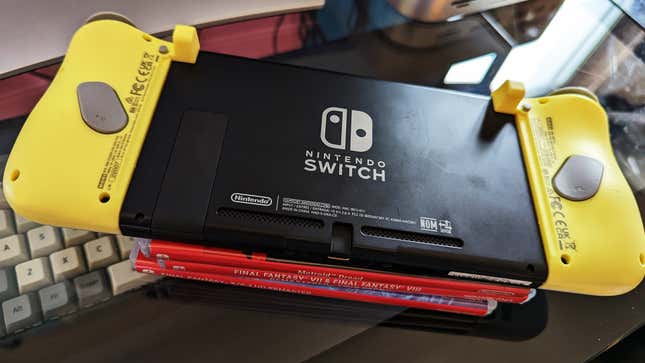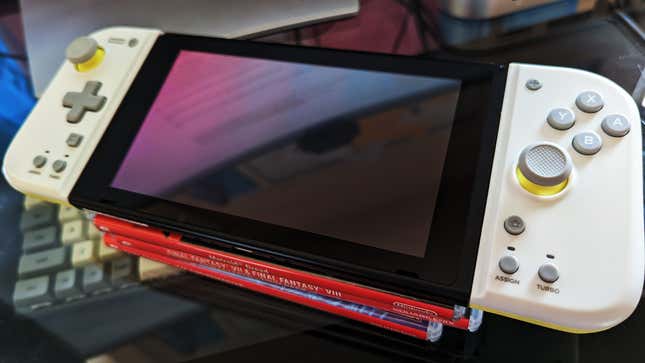
My Nintendo Switch largely sat unplayed for the duration of the pandemic. I purchased it in the Before Times thinking it’d make for a great subway companion. But between the short battery life and it being uncomfortable to hold for long periods, I just didn’t ever want to play it much. But there might finally be some light on my Switch’s horizon. Over the last few weeks I’ve been testing Hori’s new Split Pad Compact controller. While it has some cool unique features of its own, the best part might be the way that it’s encouraged me to spend more time with my Switch.
Hori’s Split Pad Compact is the successor to its prior Split Pad Pro. Taking the place of traditional Nintendo Joy-Cons, its two halves slot into the usual spaces for portable play on a standard Switch. The Compact’s colors, shape, and general playability have won me over, but it comes with some major caveats: no rumble, no wireless, and no motion-sensing features.
This is an unfortunate trend among many third-party Switch controllers given the variety of proprietary tech Nintendo employs on the console. That might entirely rule out the Split Pad Compact for some games, or for players who (justifiably) find those features essential to the Switch. But if you’ve wanted to check out an alternative to the standard Joy-Con that makes for, in my opinion, a way more comfortable portable experience, the $50 MSRP isn’t too bad for such a thing.
The buttons and design also feel rather at home with the Switch. These don’t feel like Xbox or PlayStation buttons. They sit a little bit taller than on a regular Joy-Con, but the trade-off is that I find them a bit more tactile. The analog thumbsticks are much closer to full-size ones (thank god), and overall it has a nice “Nintendo-y” feeling.
The Split Pad Compact is far from the only ergonomically shaped Switch controller (or grip) out there. What really sets it apart in terms of function are the back buttons. These buttons aren’t going to rival an Xbox Elite controller’s paddles, as there are only two of them, but I kinda like it that way. There’s also a turbo feature which lets you rapid-fire a button of your choice. In the games I played, I found little utility with this; turbo will appeal more to those into older-style action games, or RPGs where you have to page through a million text boxes.

Assigning a face button to either of the two rear inputs is a simple three-button combo. You hold down “Assign,” along with the button you wish to map (the capture and home buttons aren’t allowed), then click the rear button you want to assign to; the light will stay on as a solid red to indicate you’ve done it right. Sometimes it takes a couple of tries, but eventually you get the feel for it. There are no profiles for different games, which is a bummer. Switching up button remaps is easy though once you get it, and there are only two back buttons at most to worry about anyway. But there’s another critical limitation here.
Each rear button can only be assigned to the buttons that are on the individual “Joy-Con” itself. Basically, the right back button can only be assigned A, B, X, Y, since they are on the right-side unit. The left button can only activate buttons on the left-hand side.
While I initially grimaced at the rear inputs being limited thus, I ended up finding some great utility in The Legend of Zelda: Breath of the Wild. After playing this game with the Hori, I’ve come to realize that, OK, weapons breaking ain’t so bad; what was most annoying was actually just having to move my thumb from stick to d-pad for a mid-battle swap, which sort of slows down the pace. Mapping the weapon menu to a rear button neatly resolves this. Much nicer.
I also revisited the remastered version of Final Fantasy VIII—you know, the one with the damn digital movement controls that completely wreck the experience, which I will never shut up about. It hardly requires fast button combos (outside of a few sequences) or really even needs a back button; but the shape of the Split Pad Compact fits so much better in my hands that reading through its endless gray text boxes is just a more pleasant way to physically play.

A few smaller, indie games have come and gone during my time with the Split Pad Compact. I also put in more time with Metroid Dread. The added hand real estate of the slightly larger Hori controller just made it more enjoyable. My Switch feels like a mini Steam Deck now, as opposed to the more horizontal phablet experience the stock Joy-Cons make for.
I’m not always using the Hori’s advanced features, like turbo and the rear buttons, but what I am doing is playing my damn Switch. Regularly even!
And that simplicity, the feeling of these things just sort of getting out of your way so you can have a more comfortable experience on the Switch is the best part of this new controller. (Oh, and in case you’re wondering, yes, according to Hori, these work on both the original Switch and OLED models). The inherent limitations of zero rumble support, no wireless functionality, and no motion sensing will be clear deal breakers in many cases. But if, like me, you’ve found the Switch something of an ergonomic horrorshow, you might find the Hori Split Pad Compact a pretty great excuse to start playing it again, even if you just want to catch up on the many hits this console’s enjoyed in your absence.





